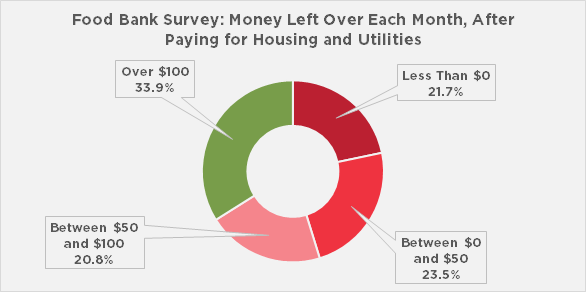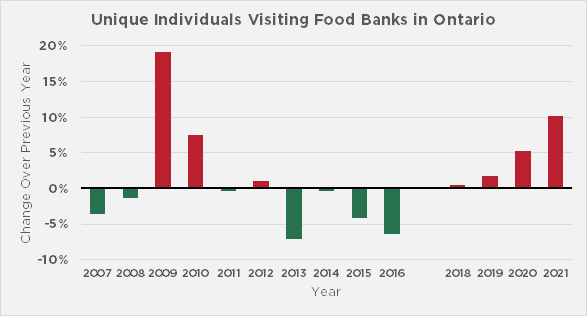In many ways, food banks are like the first responders of social supports: they’re there to help during an emergency, but aren’t designed or intended to be a cure for ongoing needs.
Helping people through the fallout of an unexpected disaster is where food banks excel. Community responses can help fill the gap between immediate needs during an emergency and the ability of a big system to respond quickly.
Unsurprisingly, over the first year of the pandemic, food bank visits across Ontario shot up by 12% over the previous year, as revealed in our latest Hunger Report.
But emergencies are sudden, unexpected, immediate. When an “emergency” lasts for weeks, months, or years, it becomes a predictable crisis that needs systemic solutions, not a charitable response.

Systemic solutions in the form of new government supports appeared at the beginning of the pandemic and saved many from financial catastrophe. Unfortunately, many supports ended last year or were only one-time benefits, despite persistently high unemployment and a rising cost of living.
One of the most crucial supports, the Canada Emergency Response Benefit (CERB), ended in September 2020. This resulted in many recipients then being moved to Employment Insurance (EI). For many people, this meant a drop in income from $2,000/month to $1,600/month, the minimum for pandemic-enhanced EI.
A $400 difference is enough to move many people from ‘barely making ends meet’ to ‘choosing between paying for rent or groceries.’ Unsurprisingly, the proportion of food bank visitors who relied on EI as their primary source of income doubled over last year.
But some people fell through the cracks of the systemic responses entirely. When we surveyed food bank visitors in September 2021, 55% of respondents with a disability received ‘no additional benefits’ during the pandemic. Coupled with frozen Ontario Disability Support Program rates and increased costs of living, it’s unsurprising that 61% of respondents said they were ‘worse off’ financially compared to before the pandemic.
This precarity is not just a side-effect of COVID-19. Visits to food banks have been increasing in Ontario for the last four years. While the pandemic brought new challenges, it also worsened existing conditions that drive food insecurity, including precarious work, inadequate social assistance rates, and unaffordable rent.

In response, food banks have continued to work hard to help address some immediate needs. Over 90% of Feed Ontario’s member food banks provide additional services. They recognize that visitors often have needs that are far more complex than just food.
But while food banks can provide help with job searches, they can’t make the jobs available safer and better-paid. They can run tax clinics to help people access benefits, but they can’t create government benefits where there are none. They can help furnish an apartment, but can’t make that apartment’s rent affordable.
The government, however, does have the power to affect change on poverty. They also are legally required to do so. Canada has signed international agreements that enshrine food as a human right. This means the government must respect, protect, and fulfill the right to food, which includes facilitating access to the income needed to purchase food.

Throughout the pandemic, we have seen how fast governments can solve problems during an emergency. Right now, we’re facing a crisis. Despite the gradual re-opening of the economy over the past few months, food bank use continues to grow. Visits in September 2021 were 32% higher than the 2017-2020 average.
Immediate action needs to be taken to close the gap between income and the cost of living. This will help ensure that fewer people need to turn to food banks. As Ontario moves towards its next election in June 2022, it is essential all parties work together to develop strong income security and affordability solutions. Together, we can build a province where no one goes hungry.
→ Read Feed Ontario’s Hunger Report 2021
→ Learn more about Feed Ontario’s policy recommendations
